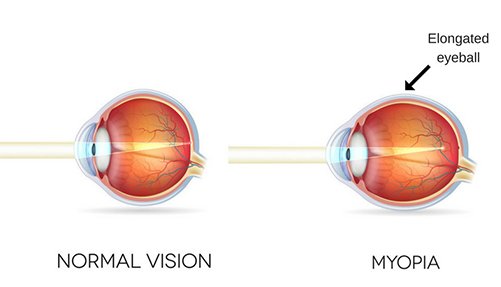What is Phakic IOL Implantation?
In the phakic IOL procedure, an intraocular lens (IOL) is placed inside the eye but the patient’s natural lens is not removed. The lens may be placed in front of or behind the iris, or may be secured to it. Phakic lens implants are a safe, effective option for patients who have high myopia (good near vision and poor distance vision), or who have thin corneas that are unsuitable for laser eye surgery. Unlike Refractive Lens Exchange (RLE), the natural focusing ability of the eye remains because the natural lens is left unaltered, and the procedure is reversible.
Phakic IOL procedures are most commonly performed on healthy patients who have high levels of myopia, but are not yet presbyopic, and who have no eye disease; no iris, pupil, or corneal abnormality; and no history of retinal detachment. Phakic IOL is an alternative to RLE (refractive lens exchange) for people with high levels of myopia because there is a reduced risk of retinal detachment.
What Is Myopia?
The cornea (clear front part of the eye) bends light entering the eye, and the lens (behind the iris) bends it more. Between them, the cornea and lens should focus that incoming light on the retina to give you clear vision. A myopic eye has a curved cornea causing it to bend light too much. By the time that light passes through the lens it has been refracted so much that it focuses in front of the retina causing light-sensitive cells in the retina do not receive full image information. What they do receive, they pass on to the brain via the optic nerve and the brain does its best to interpret the partial information and supply names for you. You have blurry vision for distant objects but can see clearly up close because close-up objects need the light to be bent more than far objects do. Your eyes are supplying enough refraction for the close-up things but cannot reduce refraction enough to give you clear images of far objects.

What are the Potential Benefits of Phakic IOL Implantation?
- Good-to-excellent far vision without contact lenses or glasses.
- The IOLs are removable.
- Reduced risk of glare, halos, or problems with low lighting that can result from high laser treatments.
- The natural lens is not removed, which means that the near focusing ability of the eye is preserved in patients under 40-years old.
How Does a Verisyse IOL Work Compared to LASIK?
In principle it works the same way as a LASIK surgery: it changes the way your eyes refract light. In practice, it takes another route to accomplish this goal.
LASIK vaporizes tiny pieces of corneal tissue to flatten the corneal curvature. The new curvature bends light so you have clear vision at all distances.
A Verisyse IOL bends incoming light rays, modifying the refraction already being done by both the cornea and the lens. The result is correct refraction for distance vision. The eye’s lens will take care of near vision altering its own curvature, a process called accommodation.
What are the Types of Phakic IOLs?
Especially useful for people younger than age 45 years old with significant nearsightedness (myopia), phakic IOLs offer a permanent solution without removing the eye’s natural lens. The FDA has approved two types of phakic IOLs, and we’ll review which one is a better option for you during your visit.
- Visian ICL: Known as a “posterior chamber” IOL, Visian is placed behind your iris, the colored part of your eye and vaults above your natural lens. Made from a biocompatible material called Collamer®, Visian lenses complement the natural chemistry of your eye, ensuring a comfortable experience and little risk of dry eye syndrome. These lenses also offer astigmatism correction.
- Verisyse: This “anterior chamber” lens is placed in front of your iris, rather than behind it. Made from a medical-grade polymer, its one-piece design makes it simple to implant. This lens is less commonly used, but may be offered in certain circumstances.
Like LASIK, the IOL placement procedure is brief. Most patients without corneal astigmatism can expect vision of 20/40 or better after implantation.
Understanding The Verisyse Procedure
It is more like a cataract procedure than LASIK, except that your natural lens will not be removed. It is an outpatient procedure taking between 15 and 30 minutes where doctors use a laser to make one or two tiny perforations at the edge of the iris that you will not be able to see. These are to allow fluid to move between the areas behind and in front of the iris.
Eyedrops are used to reduce the size of your pupils and anesthetic drops will numb the eyes. Then a tiny incision is made to insert the Verisyse IOL in front of your iris and is centered in front of the pupil and attached to the iris for stability. Tiny dissolvable stitches close the incision and a temporary shield is placed over the eye to protect it during your recovery period.
Most people achieve better than 20/20 vision with a Verisyse IOL. Many achieve 20/20, and all are extremely pleased with the results.
What Should I Expect During Recovery and Postoperative Care?
The day after your surgery, you’ll come in for an office visit to help ensure that you’re healing properly. Some patients have blurred vision the day after surgery, while some already see clearly-every patient heals differently.
Your sight should improve within a few days. For the first four to seven days after phakic IOL implantation, you should avoid heavy lifting or bending over. After the first week, you can resume most of your normal activities, but you should avoid lifting heavy items and swimming for the first month following surgery.
Contact SightMD today to schedule an appointment with one of our doctors to discuss your vision health at one of our convenient locations!

Common Cataract Post-Surgery Experiences
Managing Common Cataract Post-Surgery Experiences Cataract surgery is a transformative procedure that restores clarity and vision to those affected…

Understanding Glaucoma vs. Cataracts
Understanding the Differences of Glaucoma & Cataracts When it comes to eye health, conditions like glaucoma and cataracts can…

Is Diabetic Retinopathy Reversible?
Can Diabetic Retinopathy Be Reversed? Diabetic retinopathy is a serious eye condition that affects individuals with diabetes, potentially leading…